
CONSUMER FINANCIAL PROTECTION BUREAU | FEBRUARY 2019
Suspicious Activity Reports
on Elder Financial
Exploitation: Issues and
Trends
Office of Financial Protection for Older Americans
1 CONSUMER FINANCIAL PROTECTION BUREAU
Table of contents
Executive Summary .................................................................................................. 3
Key findings ............................................................................................. 3
1. Introduction ......................................................................................................... 6
2. Background ......................................................................................................... 8
3. Trends in SAR submissions .......................................................................... 11
SAR filings on elder financial exploitation quadrupled from 2013 to 2017 .. 11
Money services businesses have filed an increasing share of EFE SARs .. 12
4. Monetary losses reported in EFE SARs ...................................................... 14
Filers reported a total of $1.7 billion in suspicious activities in 2017 .......... 14
Nearly 80 percent of EFE SARs involved a monetary loss ........................ 15
Older adults’ monetary losses were more common and greater than filers’
losses ............................................................................................ 15
One third of the individuals who lost money were ages 80 and older ......... 16
Adults ages 70 to 79 had the highest average monetary loss .................... 17
Monetary losses were greater when the older adult knew the suspect ....... 17
5. Patterns in EFE SARs ...................................................................................... 19
Types of suspicious activity varied significantly by filer ............................. 19
More than half of EFE SARs involved a money transfer ............................ 21
Checking or savings accounts had the highest monetary losses ................ 22
The suspicious activity reported in a SAR took place, on average, over a
four-month period ........................................................................... 22
Fewer than one-third of EFE SARs indicated that the filer reported the
suspicious activity to a local, state or federal authority ..................... 23
6. Implications and Next Steps .......................................................................... 25
2 CONSUMER FINANCIAL PROTECTION BUREAU
APPENDIX A: METHODOLOGY ....................................................................... 28
APPENDIX B: DETAILED TABLES ................................................................. 31
APPENDIX C: BUREAU INITIATIVES TO HELP FINANCIAL
INSTITUTIONS FIGHT ELDER FINANCIAL EXPLOITATION .............. 34
APPENDIX D: GLOSSARY ................................................................................ 35
3 CONSUMER FINANCIAL PROTECTION BUREAU
Executive Summary
Since 2013, financial institutions have reported to the federal government over 180,000
suspicious activities targeting older adults, involving a total of more than $6 billion. These
reports indicate that financial exploitation of older adults by scammers, family members,
caregivers, and others is widespread in the United States. The reports also provide unique data
on these suspicious activities, which can enhance ongoing efforts to prevent elder financial
exploitation and to punish wrongdoers.
This study analyzes a rich, non-public data set to shed light on the volume and characteristics of
elder financial exploitation (EFE). The study explores the Suspicious Activity Reports (SARs)
filed with the federal government by financial institutions such as banks and money services
businesses. This is the first public analysis of EFE SAR filings since the Financial Crimes
Enforcement Network (FinCEN), which receives and maintains the database of SARs,
introduced electronic SAR filing with a designated category for “elder financial exploitation” in
2013.
This report presents findings based on selected data fields from all EFE SARs filed between 2013
and 2017. The report also presents findings based on a representative sample of SAR transcripts,
which include a narrative portion supplied by the financial institution. The findings provide an
opportunity to better understand the complex problem of elder financial exploitation and to
identify ways to improve prevention and response.
Key findings
• SAR filings on elder financial exploitation quadrupled from 2013 to 2017. In
2017, elder financial exploitation (EFE) SARs totaled 63,500. Based on recent prevalence
studies, these 2017 SARs likely represent a tiny fraction of actual incidents of elder
financial exploitation.
• Money services businesses have filed an increasing share of EFE SARs. In
2016, money services business (MSB) filings surpassed depository institution (DI)
filings. In 2017, MSB SARs comprised 58 percent of EFE SARs, compared to 15 percent
in 2013.
• Financial institutions reported a total of $1.7 billion in suspicious activities
in 2017, including actual losses and attempts to steal the older adults’ funds.
4 CONSUMER FINANCIAL PROTECTION BUREAU
• Nearly 80 percent of EFE SARs involved a monetary loss to older adults
and/or filers (i.e. financial institutions).
• In EFE SARs involving a loss to an older adult, the average amount lost was
$34,200. In 7 percent of these EFE SARs, the loss exceeded $100,000.
• When a filer lost money, the average loss per filer was $16,700.
• One third of the individuals who lost money were ages 80 and older.
• Adults ages 70 to 79 had the highest average monetary loss ($45,300).
• Losses were greater when the older adult knew the suspect. The average loss
per person was about $50,000 when the older adult knew the suspect and $17,000 when
the suspect was a stranger.
• Types of suspicious activity varied significantly by filer. When the filer was an
MSB, 69 percent of EFE SARs described scams by strangers. DI filings, in contrast,
involved an array of financial crimes, with 27 percent involving stranger scams.
• More than half of EFE SARs involved a money transfer. The second-most
common financial product used to move funds was a checking or savings account (44
percent).
• Checking or savings accounts had the highest monetary losses. The average
monetary loss to the older adult was $48,300 for EFE SARs involving a checking or
savings account while the average loss was $32,800 for EFE SARs involving a money
transfer.
• The suspicious activity reported in an EFE SAR took place, on average, over
a four-month period.
• Fewer than one-third of EFE SARs indicated that the filer reported the
suspicious activity to a local, state, or federal authority. Only one percent of
MSB SARs stated that the MSB reported the suspicious activity in the SAR to a
government entity such as adult protective services or law enforcement.
Implications for key stakeholders
• SARs indicate that elder financial exploitation is widespread and damaging.
This analysis of EFE SARs highlights the need for strong and diverse interventions by
financial institutions, law enforcement, and social services, as well as the involvement of
policymakers.
5 CONSUMER FINANCIAL PROTECTION BUREAU
• Financial institutions are filing an increasing number of EFE SARs, but in
most cases the SARs do not indicate that financial institutions are reporting
elder financial exploitation to law enforcement or adult protective services.
This is a missed opportunity to increase investigation and prosecution, and to make it
more likely that victims will receive appropriate services.
• EFE SARs are a useful and untapped resource for monitoring and
measuring elder financial exploitation. Regularly studying the trends, patterns
and issues in EFE SARs can help stakeholders enhance protections through independent
and collaborative work.
• The types of suspects and activities reported by money services businesses
and depository institutions differ significantly, and interventions can be
tailored accordingly. Key stakeholders and policymakers can read the findings and
develop new responses. This report suggests distinct strategies that MSBs and DIs can
implement.
• Law enforcement can mine the growing database of EFE SARs to be more
proactive in investigating cases and bringing more prosecutions. This use of
SARs by law enforcement can trigger new investigations, enhance ongoing inquiries, and
increase prosecutions.

6 CONSUMER FINANCIAL PROTECTION BUREAU
1. Introduction
Since 2013, financial institutions have reported to the federal government over 180,000
suspicious activities targeting older adults, involving more than $6 billion. These reports
indicate that financial exploitation of older adults by scammers, family members, caregivers,
and others is widespread in the United States. The reports also provide unique data on these
suspicious activities, which can enhance ongoing efforts to prevent elder financial exploitation
and to punish wrongdoers.
This study analyzes a rich, non-public data set to shed light on the volume and characteristics of
elder financial exploitation (EFE). The study explores the Suspicious Activity Reports (SARs)
filed with the federal government by financial institutions such as banks and money services
businesses. This is the first public analysis of EFE SAR filings since the Financial Crimes
Enforcement Network (FinCEN), which receives and maintains the database of SARs,
introduced electronic SAR filing with a designated category for “elder financial exploitation” in
2013.
1
The analysis shows that the EFE SAR monthly filings quadrupled from 2013 to 2017, with
money services businesses (MSBs) filing an increasing share of these SARs. EFE SARs likely
account for a tiny fraction of actual incidents of elder financial exploitation.
The amount of money that fraudsters and exploiters stole or attempted to steal from older adults
is substantial. In 2017, filers reported that $1.7 billion was involved in suspected incidents.
When a monetary loss occurred, older adults lost on average $34,200.
While financial institutions are increasingly filing EFE SARs, they often do not indicate that they
reported the suspicious activity to first responders. Fewer than one-third of EFE SARs specify
that filers reported the activity to adult protective services, law enforcement, or other
authorities.
1
The Consumer Financial Protection Bureau’s Office of Financial Protection for Older Americans is the author of this
report. The Bureau’s Office of Research contributed to the analysis of the SARs data and preparation of the report.
The Office would also like to recognize the support of the U.S. Department of the Treasury Financial Crimes
Enforcement Network.

7 CONSUMER FINANCIAL PROTECTION BUREAU
This report presents findings based on selected data fields from all EFE SARs filed between 2013
and 2017. The report also presents findings based on a representative sample of SAR transcripts,
which include a narrative portion supplied by the financial institution.
2
The findings provide an
opportunity to better understand the complex problem of elder financial exploitation and to
identify ways to improve prevention and response.
2
See Appendix A for detailed information about the data and methodology.

8 CONSUMER FINANCIAL PROTECTION BUREAU
2. Background
Elder financial exploitation is the illegal or improper use of an older person’s funds, property or
assets.
3
Perpetrators include a wide variety of people ranging from close family members to
offshore scammers.
4
Studies show that financial exploitation is the most common form of elder
abuse and yet only a small fraction of incidents are reported.
5
Estimates of annual losses to older
adults have ranged from $2.9 billion to $36.5 billion.
6
Financial institutions are uniquely positioned to prevent and respond to elder financial
exploitation. They often come in contact with victims and/or perpetrators. Many financial
institutions know their customers personally. In addition, financial institution personnel
frequently have the opportunity to observe how funds move from the older person to the
perpetrator. For example, a perpetrator may steal an older adult’s funds or investments from a
bank, credit union or brokerage account, or an older adult may transmit funds to a perpetrator
using a financial product.
Suspicious Activity Reports
Suspicious Activity Reports (SARs) are one way that financial services providers report a
suspected financial crime to the government and, ultimately, to law enforcement. SARs help law
enforcement entities identify individuals involved in a broad spectrum of financial crimes,
3
HHS, Nat’l Ctr. on Elder Abuse, Admin. on Cmty. Living, Types of Abuse, Financial or Material Exploitation,
https://ncea.acl.gov/faq/abusetypes.html#financial
(last visited Feb. 27, 2019).
4
MetLife Mature Market Institute, The MetLife Study of Elder Financial Abuse: Crimes of Occasion, Desperation,
and Predation Against America’s Elders (June 2011), available at
https://www.giaging.org/documents/mmi-elder-
financial-abuse.pdf (Referred to as Metlife Study); True Link Financial, The True Link Report on Elder Financial
Abuse 2015 (Jan. 2015), available at https://truelink-wordpress-assets.s3.amazonaws.com/wp-
content/uploads/True-Link-Report-On-Elder-Financial-Abuse-012815.pdf (Referred to as TrueLink Study).
5
Ron Acierno, et al., Prevalence and Correlates of Emotional, Physical, Sexual, and Financial Abuse and Potential
Neglect in the United States: The National Elder Mistreatment Study, 100 Am. J. Pub. Health 292-97 (Feb. 2010),
available at http://doi.org/10.2105/AJPH.2009.163089; Lifespan of Greater Rochester, Inc., et al., Under the Radar:
New York State Elder Abuse Prevalence Study–Self-Reported Prevalence and Documented Case Surveys–Final
Report, 50 (May 2011), available at
https://ocfs.ny.gov/main/reports/Under%20the%20Radar%2005%2012%2011%20final%20report.pdf (estimating
that only 1 in 44 cases of financial abuse came to the attention of agencies that provide services to victims of elder
abuse in New York State).
6
See Metlife Study and TrueLink Study, supra note 4. Estimates vary significantly, largely due to definitional and
methodological differences. For a discussion of the MetLife and True Link methodologies, see Tobie Stanger,
Financial Elder Abuse Costs $3 Billion a Year. Or is it $36 billion?, Consumer Reports (Sept. 29, 2015), available at
https://www.consumerreports.org/cro/consumer-protection/financial-elder-abuse-costs--3-billion-----or-is-it--
30-billion- (last visited Feb. 27, 2019). Both studies extrapolated from sample data to reach estimates of losses for the
entire older population of the United States.

9 CONSUMER FINANCIAL PROTECTION BUREAU
including elder financial exploitation. Law enforcement entities can use SARs to fight crime, as
they may use the information in SARs to trigger investigations, support ongoing investigations,
and identify subjects. Access to SARs and their use is restricted under federal law. Knowledge
concerning the existence of a SAR is strictly confidential and is generally limited to law
enforcement and financial regulatory authorities.
7
Information in SARs forms the basis for identifying emerging trends and patterns associated
with financial crimes. Those trends, in turn, help law enforcement agencies and provide
feedback to financial institutions.
8
The federal Bank Secrecy Act (BSA) mandates that financial institutions report suspicious
activity that might indicate money laundering, tax evasion, or other criminal activities to the
federal government.
9
Financial institutions file SARs with the U.S. Department of the
Treasury’s Financial Crimes Enforcement Network (FinCEN). The types of financial institutions
that must file SARs include banks,
10
casinos,
11
money services businesses,
12
brokers or dealers,
13
insurance companies,
14
mutual funds,
15
futures commissions merchants and introducing
brokers in commodities,
16
loan or finance companies,
17
and housing government-sponsored
enterprises.
18
These financial institutions must file SARs with FinCEN if certain dollar
7
Treas., FinCEN & CFPB, Memorandum on Financial Institution and Law Enforcement Efforts to Combat Elder
Financial Exploitation (Aug. 2017), available at
https://s3.amazonaws.com/files.consumerfinance.gov/f/documents/201708_cfpb-treasury-fincen_memo_elder-
financial-exploitation.pdf (Referred to as Joint Memorandum).
8
FinCEN, Guidance on Preparing a Complete & Sufficient Suspicious Activity Report Narrative (Nov. 2003),
available at https://www.fincen.gov/sites/default/files/shared/sarnarrcompletguidfinal_112003.pdf
.
9
31 U.S.C. § 5311 et seq.
10
31 C.F.R. § 1020.320. “Bank” includes a credit union, private bank, and trust company. 31 C.F.R. § 1020.100.
11
31 C.F.R. § 1021.320.
12
31 C.F.R. § 1022.320. A money services business includes any person doing business as: a currency dealer or
exchanger; a check casher; an issuer of traveler’s checks, money orders or stored value; a money transmitter; and the
U.S. Postal Service. For most of these types of businesses, there are additional criteria for whether specific entities are
included in the definition of a money services business. 31 C.F.R. § 1010.100(ff).
13
31 C.F.R. § 1023.320.
14
31 C.F.R. § 1025.320.
15
31 C.F.R. §1024.320.
16
31 C.F.R. § 1026.320.
17
31 C.F.R. § 1029.320.
18
31 C.F.R. § 1030.320.

10 CONSUMER FINANCIAL PROTECTION BUREAU
thresholds are met and the financial institution knows, suspects, or has reason to suspect a
transaction conducted or attempted by, at, or through the financial institution:
• involves funds derived from illegal activity or attempts to disguise funds derived from
illegal activity,
• is designed to evade Bank Secrecy Act regulations,
• lacks a business or apparent lawful purpose, or
• involves the use of the financial institution to facilitate criminal activity.
19
SAR filing is mandatory when a suspicious transaction involves or aggregates to at least $5,000
in funds or assets ($2,000 for money services businesses).
20
Financial institutions may also file
SARs voluntarily if the transaction is below the regulatory dollar threshold.
In February 2011, FinCEN issued an Advisory noting that SARs are a valuable avenue for
financial institutions to report elder financial exploitation.
21
FinCEN did not define the term
“elder financial exploitation” for filers or specify the minimum age at which a person is
considered a victim of elder financial exploitation. The Advisory includes several red flags that
may signal elder financial abuse. It also provides instructions on SAR filing when a financial
institution detects activity that appears suspicious. In April 2013, FinCEN introduced electronic
SAR filing with a designated category for “elder financial exploitation.” FinCEN instructs filers
to include a “clear, complete, and concise” description of the suspicious activity in the SAR
narrative field.
22
19
Joint Memorandum, supra note 8; 31 C.F.R. §§ 1020.320, 1021.320, 1022.320, 1023.320, 1024.320, 1025.320,
1026.320, 1029.320, 1030.320.
20
31 C.F.R. §§ 1020.320, 1021.320, 1022.320, 1023.320, 1024.320, 1025.320, 1026.320, 1029.320, 1030.320. In
addition, a bank must file a SAR for insider abuse involving any amount, violations aggregating to $5,000 or more
where a suspect can be identified, and violations aggregating to $25,000 or more regardless of whether the bank can
identify a suspect. 12 CFR §§ 21.11(c)(3), 163.180(d)(3)(iii), 208.62(c)(3), 353.3(a)(3), 748.1(c)(1)(iii).
21
FinCEN, FIN-2011-A003, Advisory to Financial Institutions on Filing Suspicious Activity Reports on Elder
Financial Exploitation (Feb. 22, 2011), available at
https://www.fincen.gov/sites/default/files/advisory/fin-2011-
a003.pdf (Referred to as FIN-2011-A003, Advisory to Financial Institutions).
22
FinCEN, FinCEN Suspicious Activity Report (FinCEN SAR) Electronic Filing Instructions (Oct. 2012), available at
https://www.fincen.gov/sites/default/files/shared/FinCEN%20SAR%20ElectronicFilingInstructions-%20Stand%20
Alone%20doc.pdf.
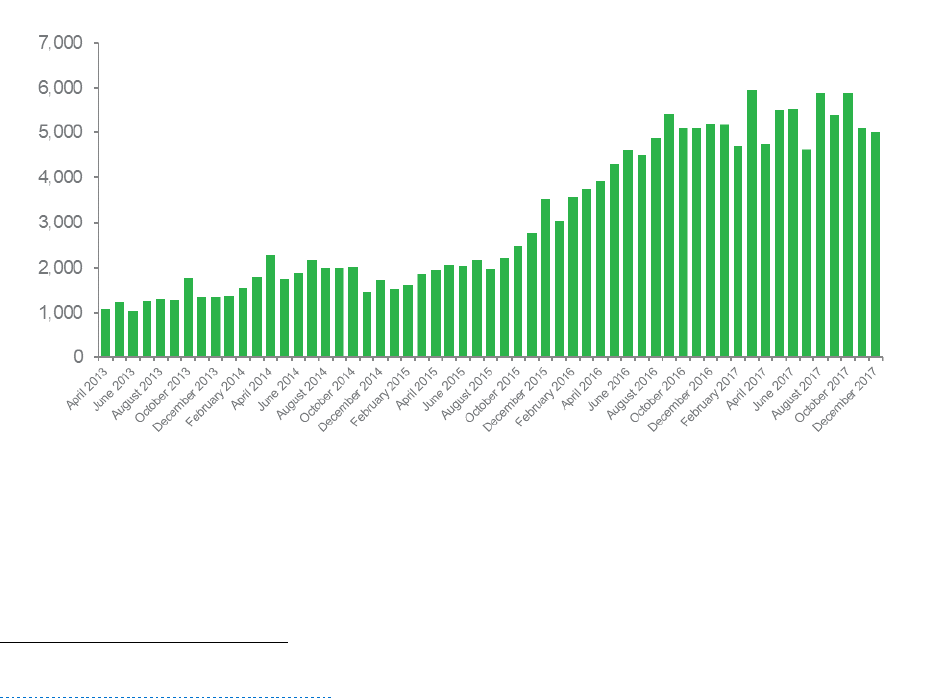
11 CONSUMER FINANCIAL PROTECTION BUREAU
3. Trends in SAR submissions
SAR filings on elder financial exploitation
quadrupled from 2013 to 2017
SARs on elder financial exploitation (EFE SARs) have increased from an average of about 1,300
filed per month in 2013 to about 5,300 filed per month in 2017. This is more than a fourfold
increase. In contrast, SARs on all types of suspicious activities have increased from an average of
about 121,200 per month in 2013 to about 161,100 per month in 2017, a 40 percent increase.
23
The rapidly increasing number of EFE SAR submissions may be due to a number of factors,
including the growing number of older adults, a possible increase in the incidence of elder
financial exploitation, growing awareness of FinCEN’s 2011 Advisory, and the addition of elder
financial exploitation as a category on the SAR form.
FIGURE 1: NUMBER OF EFE SARs BY MONTH (APRIL 2013-DECEMBER 2017)
Source: Bureau’s analysis of EFE SARs filed between April 2013 and December 2017 (176,690 SARs)
23
The number of all SARs submitted between April 2013 and December 2017 was obtained from FinCEN SARStats
https://www.fincen.gov/reports/sar-stats
(last visited Feb. 27, 2019).

12 CONSUMER FINANCIAL PROTECTION BUREAU
In total, filers (i.e. financial institutions) submitted approximately 176,700 EFE SARs between
April 2013 and December 2017. In 2017, EFE SARs filings totaled 63,500.
Despite the high number of EFE SARs in 2017, these 63,500 SARs may account for less than 2
percent of actual incidents in 2017, according to estimated prevalence rates of elder financial
exploitation.
24
Applying one of the lowest prevalence rates, 5.2 percent, to the U.S. Census’
estimated population of 71 million adults age 60 and older in 2017 results in the estimate that
more than 3.5 million older adults were victims of elder financial exploitation that year.
25
Money services businesses have filed an
increasing share of EFE SARs
Depository institutions (DI) submitted over 70 percent of all SARs on elder financial
exploitation from 2013 through 2015. In 2016, this trend shifted significantly when money
services business (MSB) filings surpassed DI filings.
26
Filings by other entities have remained a
relatively constant share of EFE SARs since 2013.
24
Estimated prevalence rates of elder financial exploitation from studies range from as low as 3.5 percent to as high
as 15 percent, depending on the age group, time period and definition of elder abuse adopted. HHS, Nat’l Ctr. on
Elder Abuse, Admin. on Cmty. Living, What is Known about the Incidence and Prevalence of Elder Abuse in the
Community Setting?, https://ncea.acl.gov/whatwedo/research/statistics.html#prevalence
(last visited Feb. 27,
2019); Michaela Beals & Martha Deevy, The scope of the problem: An overview of fraud prevalence measurement
(Nov. 2013), available at
http://longevity.stanford.edu/2013/11/14/the-scope-of-the-problem-an-overview-of-fraud-
prevalence-measurement.
25
Ron Acierno, et al., Prevalence and Correlates of Emotional, Physical, Sexual and Financial Abuse and Potential
Neglect in the United States: The National Elder Mistreatment Study, 100 Am. J. Pub. Health 292-97 (Feb. 2010),
available at http://doi.org/10.2105/AJPH.2009.163089
(showing the prevalence rate of elder financial exploitation
by a caregiver or family member); U.S. Census Bureau, 2017 American Community Survey Table S0102 Population 60
years and over in the United States 1-Year Estimates,
https://factfinder.census.gov/bkmk/table/1.0/en/ACS/17_1YR/S0102 (last visited Feb. 27, 2019).
26
In recent years, federal law enforcement agencies have brought several civil and criminal actions against large
money services businesses for, among other things, failing to meet their anti-money laundering (AML) obligations
under the Bank Secrecy Act and, specifically, failing to implement procedures to file required SARs when victims
reported fraud on transactions over $2,000. See F.T.C., MoneyGram Agrees to Pay $125 Million to Settle Allegations
that the Company Violated the FTC’s 2009 Order and Breached a 2012 DOJ Deferred Prosecution Agreement (Nov.
8, 2018),
https://www.ftc.gov/news-events/press-releases/2018/11/moneygram-agrees-pay-125-million-settle-
allegations-company (2018 agreement between MoneyGram International, Inc. and the Federal Trade Commission);
U.S. Dep’t. of Justice, Western Union Admits Anti-Money Laundering and Consumer Fraud Violations, Forfeits
$586 Million in Settlement with Justice Department and Federal Trade Commission (Jan. 19, 2017),
https://www.justice.gov/opa/pr/western-union-admits-anti-money-laundering-and-consumer-fraud-violations-
forfeits-586-million (2017 agreement between the Western Union Company, the Department of Justice, the Federal
Trade Commission and several U.S. Attorneys’ Offices); FinCEN, FinCEN Fines Western Union Financial Services,
Inc. for Past Violations of Anti-Money Laundering Rules In Coordinated Action with DOJ and FTC (Jan. 19, 2017),
https://www.fincen.gov/news/news-releases/fincen-fines-western-union-financial-services-inc-past-violations-anti-
money (related 2017 FinCEN penalty against Western Union for AML program failures and violations of its SAR filing
obligations); U.S. Dep’t of Justice, Moneygram International Inc. Admits Anti-Money Laundering and Wire Fraud
Violations, Forfeits $100 Million in Deferred Prosecution (Nov. 9, 2012),
https://www.justice.gov/opa/pr/moneygram-international-inc-admits-anti-money-laundering-and-wire-fraud-
violations-forfeits (2012 agreement between MoneyGram International Inc. and the Department of Justice).
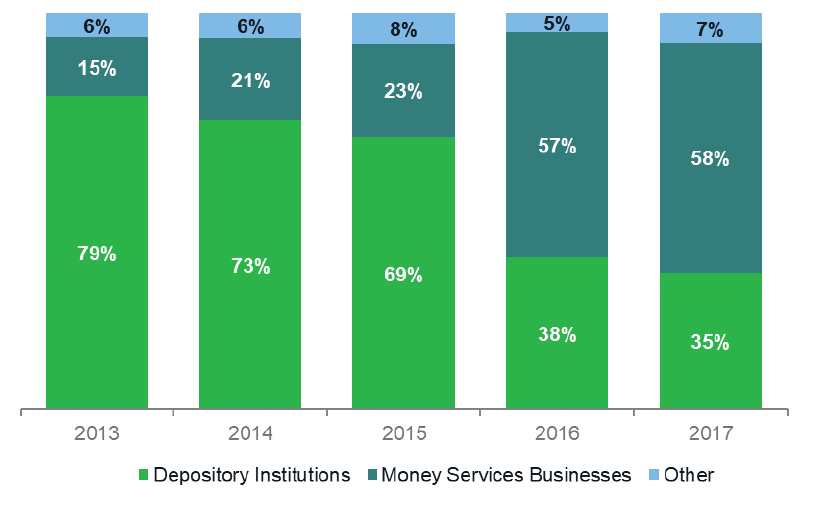
13 CONSUMER FINANCIAL PROTECTION BUREAU
FIGURE 2: PERCENT OF EFE SARs FILED BY FILER TYPE (APRIL 2013 – DECEMBER 2017)
Source: Bureau’s analysis of EFE SARs filed between April 2013 and December 2017 (176,690 SARs)
Note: “Other” filers category includes casinos, brokers or dealers, insurance companies, mutual funds, futures commissions
merchants and introducing brokers in commodities, loan or finance companies, and housing government-sponsored
enterprises.
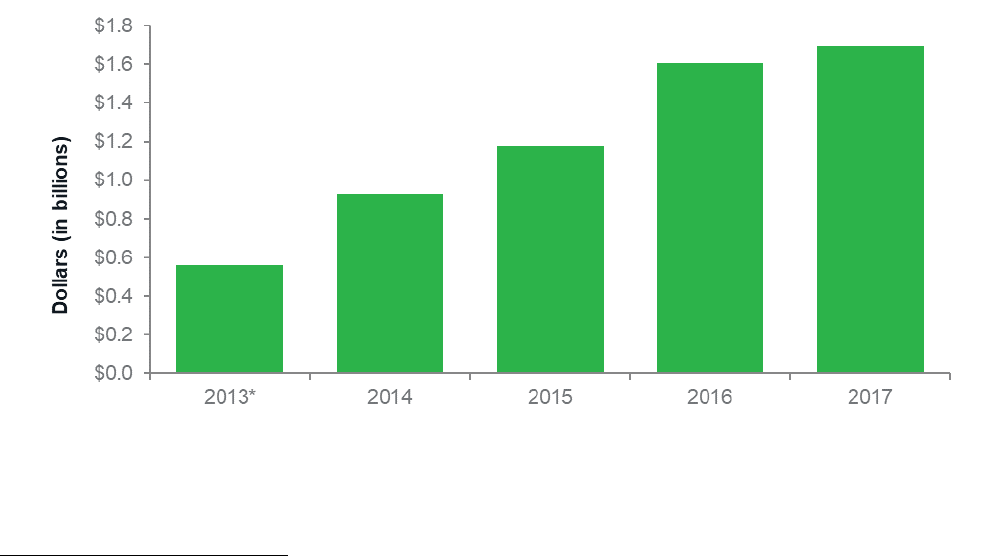
14 CONSUMER FINANCIAL PROTECTION BUREAU
4. Monetary losses reported in
EFE SARs
Filers reported a total of $1.7 billion in
suspicious activities in 2017
The dollar amounts listed in suspicious activities reported in EFE SARs include actual losses to
the older adult or to the filer, attempts to steal the older adults’ funds, or both. Financial
institutions reported $6 billion in actual losses and attempts in EFE SARs filed between April
2013 and December 2017.
27
In 2014, actual losses and attempts totaled $931 million. In 2017,
actual losses and attempts totaled $1.7 billion.
FIGURE 3: TOTAL AMOUNT OF MONETARY LOSSES AND ATTEMPTS REPORTED IN EFE SARs BY YEAR
(IN BILLIONS)
Source: Bureau’s analysis of all EFE SARs filed between April 2013 and December 2017 (183,360 SARs).
Note: Analysis includes dollar amounts reported in EFE SARs with continuing activities, but excludes EFE SARs in the
highest 1% by dollar amount per year. *Total dollar amounts for 2013 are limited to April to December.
27
The analysis excludes the top 1 percent of SARs by dollar amount involved per year. The top 1 percent of SARs
account for a total of $142.1 billion or 96 percent of all dollar amounts involved in suspicious activities for the 2013-
2017 time period. Many SARs in the top 1 percent of SARs by dollar amount, for instance, describe scams involving an
attempt to deposit a fake check purportedly worth millions of dollars or attempts to withdraw billions of dollars from
a customer’s account. These monetary amounts in suspicious activities are uncommon, rarely involve actual losses,
and result in wide variations in the total dollar amount over time. Appendix A provides more details about this
exclusion.
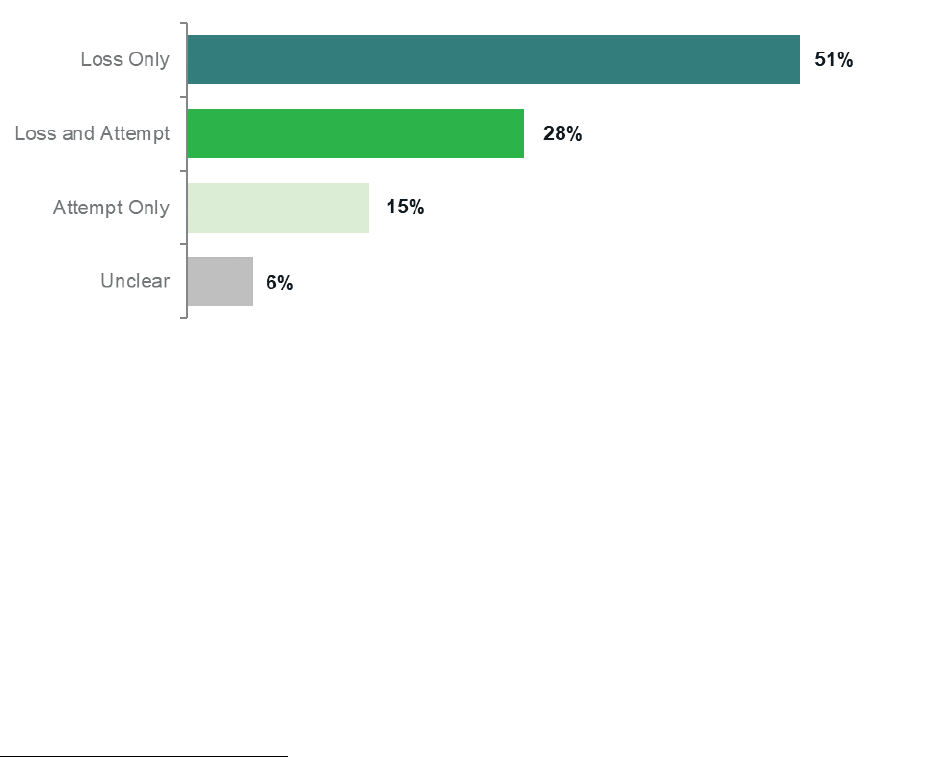
15 CONSUMER FINANCIAL PROTECTION BUREAU
Nearly 80 percent of EFE SARs involved a
monetary loss
Nearly 80 percent of EFE SARs involved a monetary loss to older adults and/or the filer. In
about half of EFE SARs, the entire amount reported was a monetary loss to older adults, the
filer, or both. In 28 percent of EFE SARs, the amount reported included both a monetary loss
and an attempted theft of the older adult’s funds.
28
Only 15 percent of EFE SARs describe solely
an attempt with no actual monetary losses involved. These SARs often describe transactions that
were blocked, rescinded, or refunded with no loss to the customer or filer.
FIGURE 4: PERCENT OF EFE SARs WITH A MONETARY LOSS AND/OR ATTEMPT (APRIL 2013 –
SEPTEMBER 2017)
Source: Bureau’s analysis of a random sample of EFE SARs (1,051 SARs)
Older adults’ monetary losses were more
common and greater than filers’ losses
In about 75 percent of EFE SARs, the targeted older adult lost money. In contrast, the filer (i.e.
the financial institution) lost money in 9 percent of all EFE SARs. Monetary losses are greater
for older adults than filers. The average amount lost per older adult was $34,200.
29
In 7 percent
28
We also use the term “partial loss” to describe the cases involving losses and attempts.
29
Average and median loss amounts reported are per older adult. Fewer than 10 percent of EFE SARs had more than
one targeted individual identified. Appendix A provides more details about this analysis.

16 CONSUMER FINANCIAL PROTECTION BUREAU
of these SARs, the loss to the older adult exceeded $100,000.
30
In contrast, the average amount
lost per filer was $16,700, and there were no cases involving losses of more than $100,000 by
the filer.
31
FIGURE 5: PERCENT OF EFE SARs WITH A LOSS TO OLDER ADULTS OR FILERS AND AVERAGE LOSS
(APRIL 2013 – SEPTEMBER 2017)
Target
Percent of EFE SARs
involving a loss
a
Average (median)
loss
Older adult 75% $34,200 (13,900)
b
Filer 9% $16,700 (14,600)
c
Source: Bureau’s analysis of a random sample of EFE SARs (1,051 SARs)
Notes: (a) Percentages include EFE SARs with partial losses. (b) Average and median loss amounts are per targeted older
adult. These amounts are based on the 44 percent of EFE SARs where the entire amount reported is a monetary loss to the
older adult. Excludes SARs with no losses or partial losses to the older adult or any losses to the filer. (c) Average and
median loss amounts for filers are based on the 2 percent of EFE SARs where the entire amount reported is a monetary
loss to the filer. Excludes SARs with no losses or partial losses to the filer or any losses to older adults.
One third of the individuals who lost money
were ages 80 and older
One third of targeted individuals who lost money were adults ages 80 and older. Given that
nearly 30 percent of EFE SARs involving a loss to the older adult do not specify the age of the
targeted older adult, it is likely that adults 80 and older may account for more than 40 percent.
32
FIGURE 6: PERCENT OF EFE SARs WITH A LOSS TO OLDER ADULTS BY AGE GROUP (APRIL 2013 –
SEPTEMBER 2017)
Source: Bureau’s analysis of a random sample of EFE SARs (459 SARs)
30
Based on the EFE SARs where the entire amount reported was a monetary loss to the older adult.
31
Based on the EFE SARs where the entire amount reported was a monetary loss to the filer.
32
FinCEN has not specified a minimum age for designating that the suspicious activity reported in a SAR constitutes
elder financial exploitation. As a result, some EFE SARs identified individuals as young as age 50 as targets of EFE.
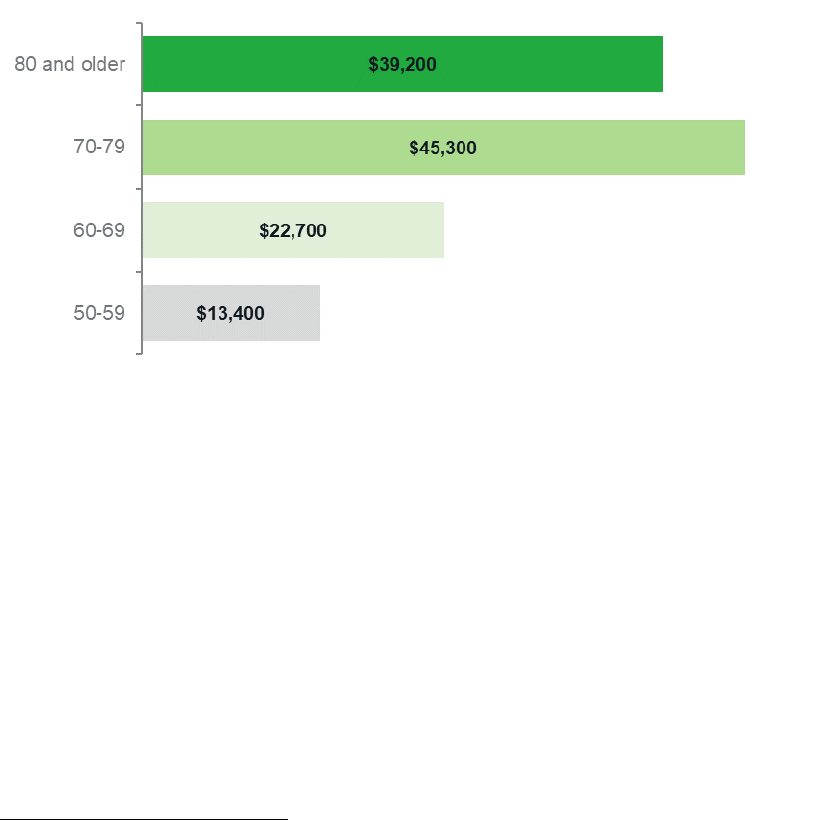
17 CONSUMER FINANCIAL PROTECTION BUREAU
Note: Excludes EFE SARs with no losses or partial losses to the older adult or any losses to the filer. Percentages do not
add up to 100 percent due to rounding.
Adults ages 70 to 79 had the highest average
monetary loss
EFE SARs involving adults ages 70 to 79 had the highest average monetary loss ($45,300). EFE
SARs involving adults ages 80 and older had the second highest average monetary loss
($39,200). The average monetary loss of $41,800 for the two oldest age categories combined
(ages 70-79 and 80 and older) is approximately $20,000 higher than the average monetary loss
of $22,000 for the two youngest age categories combined (ages 50-59 and 60-69).
FIGURE 7: AVERAGE MONETARY LOSS BY AGE OF THE TARGETED OLDER ADULT (APRIL 2013 –
SEPTEMBER 2017)
a
Source: Bureau’s analysis of a random sample of EFE SARs (324 SARs)
Note: Based on EFE SARs where the age of the targeted adult(s) is stated. Excludes EFE SARs showing no loss or a partial
loss to the older adult or any loss to the filer.
Monetary losses were greater when the older
adult knew the suspect
EFE SARs identify a variety of suspects. These suspects included strangers as well as people
known to the older adult(s).
33
33
Approximately 14 percent of all SARs do not provide enough information to determine the relationship of the
suspect to the targeted older adult.
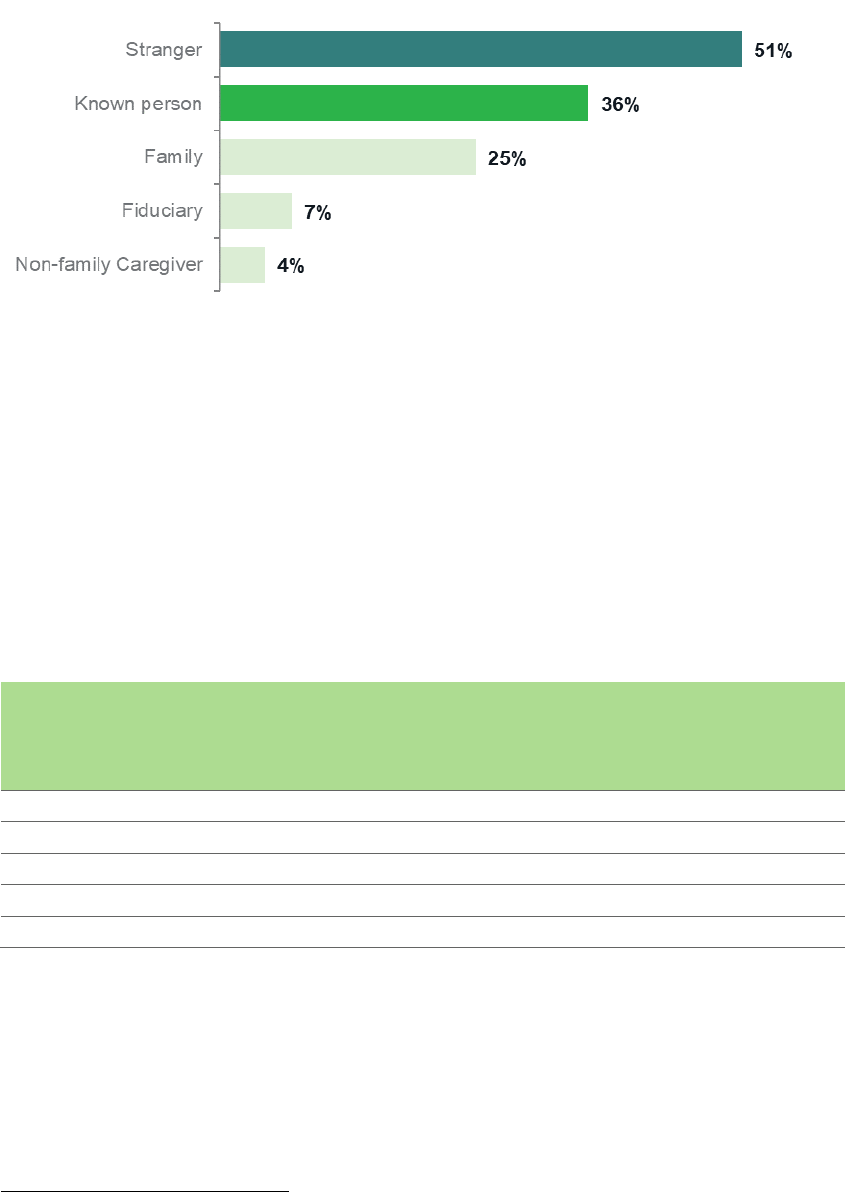
18 CONSUMER FINANCIAL PROTECTION BUREAU
FIGURE 8: PERCENT OF EFE SARs BY SUSPECT CATEGORY
Source: Bureau’s analysis of a random sample of EFE SARs (1,051 SARs)
Notes: (a) Percentages add up to more than 100 percent because EFE SARs may indicate multiple types of suspects. (b)
The known person category includes fiduciaries, family members, non-family caregivers and others individuals such as
friends, neighbors, accountants, and contractors. (c) The fiduciary category includes family members and non-family
caregivers who serve as fiduciaries. (d) The family member and non-family caregiver categories include fiduciaries.
A monetary loss was more common, and the amount lost was greater, when the older adult knew
the suspect than when suspects were strangers. In addition, a loss was more common, and the
amount lost was greater, when the suspects were fiduciaries.
34
About 7 percent of all EFE SARs
involved a suspect identified as a fiduciary, such as an agent under a power of attorney.
FIGURE 9: PERCENT OF EFE SARs WITH A LOSS TO THE OLDER ADULT AND AVERAGE MONETARY
LOSS BY SUSPECT CATEGORY (APRIL 2013 – SEPTEMBER 2017)
Suspect
Category
Percent of EFE SARs
within a suspect
category involving
a loss to the older adult
a
Average (median)
loss per older adult
b
Stranger
75%
$17,000 ($8,500)
Known person
c
79% $50,200 ($23,200)
Family
d
82% $42,700 ($24,900)
Fiduciary
e
88% $83,600 ($33,800)
Non-family caregiver
e
76%
$57,800 ($21,800)
Source: Bureau’s analysis of a random sample of EFE SARs (1,051 SARs)
Notes: (a) Percentages include EFE SARs with partial losses. (b) Average and median loss amounts per older adult are
based on the EFE SARs where the entire amount reported is a monetary loss to the older adult, and excludes SARs with no
losses, partial losses or any loss to the filer. (c) The known person category includes fiduciaries, family members, non-family
caregivers and others individuals such as friends, neighbors, accountants, and contractors. (d) The fiduciary category
includes family members and non-family caregivers who serve as fiduciaries. (e) The family member and non-family
caregiver categories include fiduciaries.
34
A fiduciary is a person with authority to manage money or property for someone else. Fiduciaries have a legal duty
to manage a person’s money and property for the person’s benefit. Types of fiduciaries include agents under a power
of attorney, guardians of property, trustees, and government benefit fiduciaries.

19 CONSUMER FINANCIAL PROTECTION BUREAU
5. Patterns in EFE SARs
Types of suspicious activity varied significantly
by filer
Elder financial exploitation SARs describe a variety of types of financial exploitation. For this
analysis, the Bureau categorized the activities described in SARs as scams and non-scams. EFE
SARs related to scams are those where the filer specifically referred to the activity as a scam or
where the filer described a scheme involving the transfer of money to a stranger for a promised
benefit that the older adult did not receive. EFE SARs not categorized as scams include a broad
array of activities, including theft by family members or others known to the older adult,
account takeovers, identity theft, and other crimes. The prevalence of these activities varied
significantly by filer type (Figure 10). Figure 11, below, provides examples of four common
activity patterns described in EFE SARs.
FIGURE 10: TYPES OF ELDER FINANCIAL EXPLOITATION ACTIVITY DESCRIBED IN SARs BY FILER TYPE
(APRIL 2013 – SEPTEMBER 2017)
Source: Bureau’s analysis of a random sample of EFE SARs (1,051 SARs)
Note: “Other” filers category includes casinos, brokers or dealers, insurance companies, mutual funds, futures commissions
merchants and introducing brokers in commodities, loan or finance companies, and housing government-sponsored
enterprises.

20 CONSUMER FINANCIAL PROTECTION BUREAU
FIGURE 11: FOUR COMMON ELDER FINANCIAL EXPLOITATION ACTIVITY PATTERNS*
Romance scam
An MSB reports that an older man requests a large money transfer to send to an
individual outside of the United States. The agent notes that the customer previously
sent small transfers abroad and asks the customer for more information about the
transaction. The customer explains that he is sending the money to his fiancée so she
can visit him. He met her online and this will be their first in-person meeting. The MSB
notes that the receiver has been the subject of previous SARs. The transaction is
blocked and the amount of the wire is refunded to the customer. The MSB does not
refund the fee. The MSB blocks future transactions by the customer.
Exploitation by
family
member/fiduciary
An older woman has a checking account at a bank. Her daughter contacts the bank
about the woman’s son. The son is the older woman’s agent under power of attorney.
The daughter claims that he is financially exploiting his mother. The bank finds that
there are a number of recent purchases and withdrawals using the customer’s debit
and ATM cards. Some transactions have occurred at liquor stores, casinos, and other
businesses that the customer has not patronized previously. In addition, a teller
informs the branch manager that the customer has visited the branch several times to
make cash withdrawals, accompanied by her son. The bank reports these incidents to
the local Adult Protective Services agency.
Theft by
caregiver
An older adult is a member of a large credit union. Credit union personnel notice an
unusual amount of activity in her account, including frequent large withdrawals at ATM
machines. In addition, an individual with a different last name has been cashing large
checks drawn on the account in person. The fraud department of the credit union calls
the member and she is unaware of the transactions. She states that the person
cashing the checks is one of her caregivers.
Money mule
A retired man received and sent numerous money transfers in a period of a few
months. He received the money transfers at several retail stores acting as agents for a
large MSB and sent the money transfers from outlets for the same MSB. The money
transfers he received originated in Europe as well as the United States. Shortly after
receiving these sums, he sent all or nearly all of the funds he received to individuals in
one African country. The MSB interviewed the man and asked him about the
transactions. He stated that he was sending funds to his nephew to help pay for food
and educational expenses. The MSB describes the pattern of transactions as “flipping.”
The MSB suspects that the man is the victim of a “person in need” scam.
*The activity patterns described above are illustrative of commonly seen elder financial exploitation patterns. They are
not based on individual or specific filings or SARs.
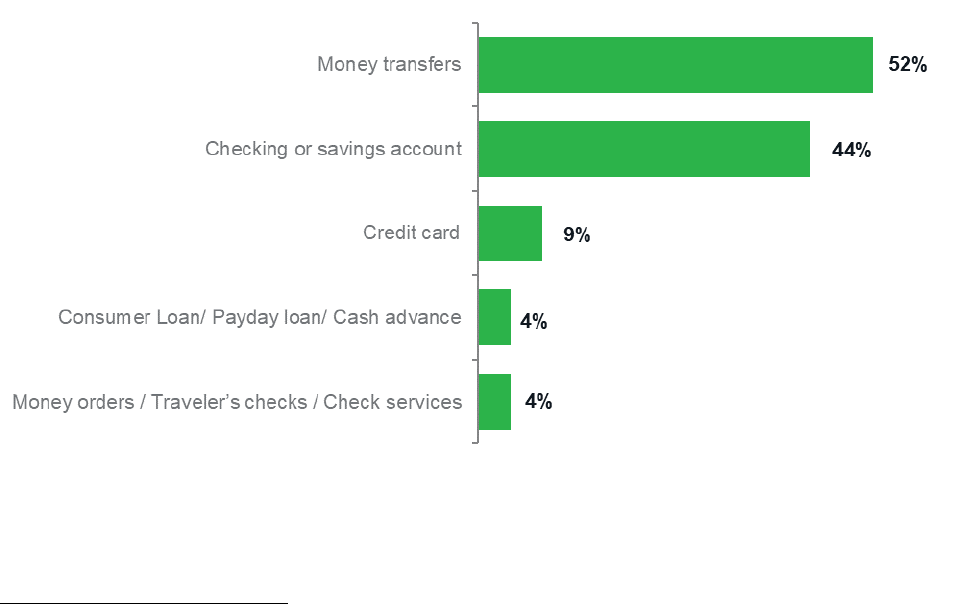
21 CONSUMER FINANCIAL PROTECTION BUREAU
Approximately 70 percent of MSB filings were related to scams. Romance, relative in need, and
lottery/sweepstake scams were the most common types of scams described in these filings. The
most common suspects in MSB filings were strangers. DI filings, in contrast, involved an array
of financial crimes. The activities described in these EFE SARs included theft, abuse of power of
attorney, and other fraudulent activity. While much less common than in MSB filings, 27
percent of DI filings involved scams. Two-thirds of suspects (66 percent) in DI filings were
people known to the older adult, while
few suspects in MSB SARs were people known to the
older adult.
More than half of EFE SARs involved a money
transfer
Funds move from the targeted person to the suspect using a variety of financial products and
services. In more than half of the EFE SARs analyzed, the targeted person used a money
transfer.
35
The second most common product was a checking or savings account (44 percent). A
credit card was the third most common product used. While most suspicious activities involved
a single type of product, two or more products were used in 19 percent of EFE SARs.
FIGURE 12: TOP 5 FINANCIAL PRODUCTS USED IN EFE SARs (APRIL 2013 – SEPTEMBER 2017)
Source: Bureau’s analysis of a random sample of EFE SARs (1,051 SARs)
Notes: Percentages add up to more than 100 percent because EFE SARs may indicate multiple types of products.
35
In a small number of SARs, the suspect conducts the money transfer. These SARs include cases of account
takeovers, where the suspect conducts a money transfer to other individuals or businesses using the older adults’
funds.

22 CONSUMER FINANCIAL PROTECTION BUREAU
Checking or savings accounts had the highest
monetary losses
The average monetary loss per older adult in EFE SARs that involved a checking or savings
account was $48,300. For SARs involving a money transfer, the average loss was $32,800, and
for a credit card, it was $32,600.
FIGURE 13: PERCENT OF EFE SARs WITH A LOSS TO THE OLDER ADULT AND AVERAGE MONETARY
LOSS BY PRODUCT (APRIL 2013 – SEPTEMBER 2017)
Product
Percent with
a loss to the older adult
a
Average (median)
loss per older adult
b
Checking or savings account
79%
$48,300 ($22,100)
Money transfer
78%
$32,800 ($9,900)
Credit card 63% $32,600 ($17,000)
Source: Bureau’s analysis of a random sample of EFE SARs (960 SARs)
Notes: (a) Percentages include SARs with partial losses. (b) Average and median loss amounts per older adult are based on
the EFE SARs where the entire amount reported is a monetary loss to the older adult. Excludes SARs with no losses or
partial losses to the older adult or any losses to the filer.
The suspicious activity reported in a SAR took
place, on average, over a four-month period
For each SAR, filers are required to provide the range of dates during which the suspicious
activity or activities occurred.
36
The average length of the suspicious activities in EFE SARs is
approximately four months (120 days).
37
In four specific situations, the suspicious activity in
EFE SARs lasts longer than the average length of time: when a joint account is involved (230
days); when a family member is the suspect (197 days); when the targeted person has
diminished capacity (158 days);
38
and when the targeted person is 80 years old and older (134
days). In nearly 30 percent of EFE SARs, activities span 10 days or fewer, and in 27 percent,
activities span 100 days or more.
36
Filers appear to use a variety of methods to assess the length of activity once a suspicious pattern becomes
apparent. In some SARs, they appear to use technology to look back at similar past transactions involving common
counterparties.
37
Bureau’s analysis of a random sample of EFE SARs (1,051 SARs).
38
In these SARs, the filer specifically mentioned that the targeted older adult had or appeared to have diminished
capacity or was under guardianship.

23 CONSUMER FINANCIAL PROTECTION BUREAU
Fewer than one-third of EFE SARs indicated
that the filer reported the suspicious activity to a
local, state or federal authority
Research shows that only a small fraction of elder financial exploitation cases are reported to an
agency that can provide services to the older consumer.
39
Prompt reporting of suspected
financial exploitation to adult protective services, law enforcement, and other agencies can
trigger appropriate intervention, prevention of financial losses, and other remedies. SARs can
provide information to law enforcement and certain regulators about suspected elder financial
exploitation and references to supporting documentation that can trigger an investigation,
support an ongoing investigation, or identify previously unknown subjects and entities.
However, many law enforcement entities do not have direct access to FinCEN’s SAR database.
40
Moreover, law enforcement entities and financial regulatory authorities do not receive notice
when a financial institution files a SAR.
Fewer than one-third of EFE SARs (28 percent) indicate that the filer reported the suspicious
activity to a local, state or federal authority.
41
When filers did report suspicious activities to an
authority, they reported three times more often to adult protective services
42
(23 percent) than
to law enforcement (7 percent).
39
Lifespan of Greater Rochester, Inc. et al., Under the Radar: New York State Elder Abuse Prevalence Study–Self-
Reported Prevalence and Documented Case Surveys–Final Report, 50 (May 2011), available at
https://ocfs.ny.gov/main/reports/Under%20the%20Radar%2005%2012%2011%20final%20report.pdf.
40
Law enforcement entities that do not have a Memorandum of Understanding with FinCEN that allows such access
may be able to obtain SARs through their state or regional points of contact. See Joint Memorandum, supra note 8.
41
The SAR form contains a set of fields where filers can provide the contact information of any law enforcement
agency that the financial institution contacted. The narrative portion of the SAR may also include this type of
information.
42
Adult Protective Services (APS) are social services programs provided by states nationwide, serving older adults
and adults with disabilities who are in need of assistance. If APS finds that a person has experienced or is at risk of
experiencing financial exploitation, APS can decide what services, if any, are necessary for the vulnerable adult’s
safety or well-being and recommend a service plan. See Nat’l Center on Elder Abuse, What We Do,
https://ncea.acl.gov/whatwedo/practice/intervention-APS-howitworks.html
(last visited Feb. 27, 2019).
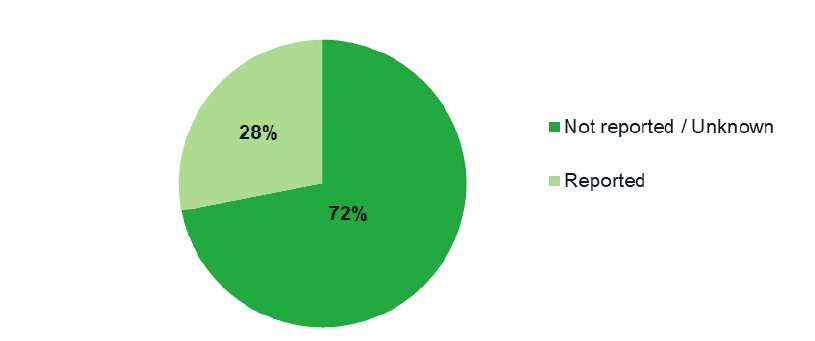
24 CONSUMER FINANCIAL PROTECTION BUREAU
FIGURE 14: PERCENT OF EFE SARs NOTING A REPORT TO A LOCAL, STATE OR FEDERAL AUTHORITY
(APRIL 2013 – SEPTEMBER 2017)
Source: Bureau’s analysis of a random sample of EFE SARs (1,051 SARs)
Reporting of suspicious activities to a local, state, or federal authority varied significantly by filer
type. For example, slightly more than half of DI SARs indicate that the DI reported the
suspicious activity in the SAR to a government entity other than FinCEN, while only one percent
of MSB SARs indicate that the MSB reported the suspicious activity in the SAR.

25 CONSUMER FINANCIAL PROTECTION BUREAU
6. Implications and Next Steps
The trends and patterns documented in this study provide new insight into the dimensions and
nature of financial exploitation of older adults and the responses of financial institutions when
they see it. Financial institutions, law enforcement, social service agencies, and policymakers at
the local, state, and federal level can use these detailed findings to strengthen efforts to prevent,
detect, and respond to this major threat to the financial security of older adults. The more than
fourfold increase in EFE SAR filings from 2013 to 2017 suggests that financial institutions are
taking the threat of financial exploitation more seriously and reporting it to FinCEN when they
see it.
SARs indicate that elder financial exploitation is widespread and damaging. In 2017
alone, financial institutions filed 63,500 EFE SARs. Filers reported $1.7 billion in suspicious
activities in 2017. The great majority of these amounts represent losses to older adults—and the
average individual loss to an adult over age 70 was $41,800. These reports likely represent just a
tiny fraction of this pervasive problem: elder financial exploitation SARs in 2017 likely
document fewer than 2 percent of an estimated 3.5 million cases in 2017.
43
This analysis of EFE
SARs highlights the need for strong and diverse interventions by financial institutions, law
enforcement, and social services, as well as the involvement of policymakers.
Financial institutions are filing an increasing number of EFE SARs, but in most
cases the SARs do not indicate that they are reporting elder financial exploitation
to law enforcement or adult protective services. Fewer than one-third of EFE SARs (28
percent) say that the filing institution reported the activity to adult protective services, law
enforcement or other authorities – and only 1 percent of MSB SARs say that the filers made such
reports. If the financial institution is not reporting to adult protective services, law enforcement
or other authorities, this is a missed opportunity to strengthen prevention and response. More
reporting to the relevant law enforcement agencies can increase investigation and prosecution.
Robust reporting to APS can increase the likelihood that victims will receive appropriate
services.
EFE SARs are a useful and untapped resource for monitoring and measuring elder
financial exploitation. The information in EFE SARs sheds light on the monetary amounts at
risk, characteristics of the targeted individuals, the nature of the suspects, the types of scams
and frauds that are most common, and the types of transactions used to siphon funds from older
43
Supra note 25.

26 CONSUMER FINANCIAL PROTECTION BUREAU
adults to bad actors. All of this information is provided through the unique lens of financial
institutions. Regular studies of the trends, patterns and issues in EFE SARs can help financial
institutions, law enforcement, service providers, and policymakers to enhance efforts to protect
older adults from financial exploitation. These entities can work independently as well as
collaboratively through community response networks.
44
The types of suspects and activities reported by money services businesses and
depository institutions differ significantly, and interventions can be tailored
accordingly. Most cases of EFE reported by MSBs are scams by strangers, while depository
institutions more often report theft by people the older adult knows and a broad array of other
financial exploitation activities. Two-thirds of suspects in depository institution filings were
people known to the older adult; in contrast, 2 percent of suspects in MSB filings were people
known to the older adult. EFE SARs involving bank accounts documented substantially higher
monetary losses than those involving money transfers. And the SARs indicate that when older
adults know the perpetrator, they lose more money than when the perpetrator is a stranger.
These patterns suggest that prevention and intervention strategies can be tailored to the types of
financial institutions where they occur and the types of perpetrators. Key stakeholders and
policymakers can read the findings and develop new responses. But some responses already
exist and can be fully and widely implemented in whichever type of institution they apply.
• Money services businesses could prevent more losses by blocking money transfers to
people who previously aroused suspicion, providing conspicuous warnings about current
scams on money transfer forms, and thoroughly training all agents, from the large chains
to the small stores. MSBs could assist victims of fraudulent activity by refunding money
transfer amounts and associated fees when appropriate and by ensuring that agents and
frontline employees are complying with anti-fraud programs and controls.
45
• Depository institutions could prevent or limit losses by improving fraud detection
technology to reflect transaction patterns most prevalent when older account holders
become victims and by using machine learning to obtain specific and timely information
44
CFPB, Report and Recommendations: Fighting Elder Financial Exploitation through Community Networks,
(Aug. 2016), available at
https://files.consumerfinance.gov/f/documents/082016_cfpb_Networks_Study_Report.pdf
.
45
MSBs have agreed to implement these and other actions in consent agreements such as the 2018 agreement
between Moneygram International and the Federal Trade Commission. Supra note 26.

indicating fraudulent activity.
46
Depository institutions can promote use of alerts on
checking and savings accounts, and can offer services to enable trusted relatives and
friends to help detect elder financial exploitation.
47
Financial institutions, regulators and
policymakers could collaborate to identify and consider any changes needed to enable
depository institutions to hold transactions while investigating suspicious activity. They
might want to look at state activity in this arena. Several states allow transaction holds
when staff observe financial exploitation and report it to APS and/or law enforcement.
48
These states provide timeframes for the transaction holds and provide immunity for
institutions and employees who take these protective steps.
Law enforcement can mine the growing database of EFE SARs to be more
proactive in investigating cases and bringing more prosecutions. The database
provides law enforcement with the opportunity to access reports of a variety of suspected
financial crimes targeting older adults. Law enforcement agencies—local, state, and federal—can
mine this database to trigger new investigations and enhance ongoing inquiries. Cases can be
strengthened using important information and documentation from SARs, and the number of
prosecutions can increase.
27 CONSUMER FINANCIAL PROTECTION BUREAU
46
CFPB, Recommendations and report for financial institutions on preventing and responding to elder financial
exploitation, (Mar 2016), available at https://files.consumerfinance.gov/f/201603_cfpb_recommendations-and-
report-for-financial-institutions-on-preventing-and-responding-to-elder-financial-exploitation.pdf.
47
Id.
48
See, e.g., Washington (Wash. Rev. Code §74.34.215), Delaware (Del. Code Ann. tit.6 §73-307, Del. Code. Ann. tit. 31
§3910), Kentucky (Ky. Rev. Stat. Ann. §365.245), and Texas (Tex. Finance Code Ann. §280.004, Tex. Rev. Civ. Stat.
Ann. Art. 581, §45).
28 CONSUMER FINANCIAL PROTECTION BUREAU
APPENDIX A: METHODOLOGY
RESEARCH TEAM
The research team includes Hector Ortiz, Naomi Karp, Jenefer Duane and James Miner from
the Bureau’s Office of Financial Protection for Older Americans, and Judith Ricks and Catherine
Razeto from the Bureau’s Office of Research.
DATA
The Bureau analyzed data from Suspicious Activity Reports related to elder financial
exploitation filed between April 1, 2013 and December 31, 2017. Beginning in April 2013, SAR
filers were required to use the electronic SAR form which includes a checkbox where filers can
flag the activity as elder financial exploitation. For the purposes of this study, EFE SARs were
those in which the filer selected the elder financial exploitation checkbox (field 35d) or selected
“other” under the suspicious activity category and wrote some variation of “elder” in the open
text field (fields 29z-38z). The Bureau analyzed structured data from all EFE SARs filed between
April 2013 and December 2017 to obtain the total amounts involved in suspicious activities and
the total number of filings by filer type and year.
In order to provide a meaningful description of the activities, trends and issues reported in EFE
SARs, the Bureau also relied on the analysis of a sample of 1,051 SARs, which included a review
of narratives and other unstructured data. This sample was designed to be representative of all
SARs submitted during the between April 2013 and September 2017 (95% confidence level, +-
3% confidence interval). The Bureau used the Master Activity Identifiers to draw the random
sample of EFE SARs used in this report. All related SARs in the FinCEN SAR database have a
common Master Activity Identifier. Related SARs provide information on suspicious activity
that continues (Continuing Activity SARs) or include a correction to a previous filing (Correction
SARs). Table 1 provides a comparison between EFE SARs in the random sample and all EFE
SARs filed during the same time period.
For the analysis of the random sample of EFE SARs, a group of Bureau employees with
authorized access to SARs, and with expertise in the topic of elder financial exploitation, read
these SARs and summarized each using codes. To ensure consistency in coding among team
members, the team regularly discussed, reviewed and compared each member’s coding
approach. The team analyzed the information in this sample of SARs and the codes to generate
the findings about the type of elder financial exploitation involved, the suspect’s characteristics
and relationship to the targeted individual, the targeted individual’s characteristics, types of
products and transactions involved, length of activity, whether amounts involved losses or
attempts, and whether an activity was reported to the authorities. The reading group did not
review documentation referenced in the SARs.

29 CONSUMER FINANCIAL PROTECTION BUREAU
TABLE 1: COMPARISON OF RANDOM SAMPLE OF EFE SARs WITH ALL EFE SARs (APRIL 2013-
SEPTEMBER 2017)
ANALYSIS OF MONETARY AMOUNTS
Total suspicious activity amounts: To obtain the total dollar amount involved in suspicious
activities (i.e. losses and attempts), the Bureau included the dollar amounts in Continuing
Activity SARs. The Bureau excluded the top 1 percent of each year’s EFE SARs by dollar amount
involved (1,854 SARs). Excluding the top percentile is a common research technique for
correcting distortions in data due to outliers. This exclusion enabled the Bureau to study the
changes in the total amount involved over time for the remaining 99 percent of EFE SARs. A
percentile-based exclusion also prevents an unintended disclosure of a SAR (prohibited by the
Bank Secrecy Act). The excluded SARs account for a total of $142.1 billion in suspicious
activities between April 2013 and December 2017. Table 2 provides data on the number of SARs
and the amounts excluded by year.
TABLE 2: AMOUNTS EXCLUDED IN ANALYSIS OF EFE SARs BY YEAR IN MILLIONS (APRIL 2013-
DECEMBER 2017)
Year
All SARs
a
(#)
All SARs
($ in
millions)
Top 1%
(#)
Top 1%
($ in
millions)
Bottom 99%
(#)
Bottom 99%
($ in
millions)
2013
12,124
$22,013.9
122
$21,454.3
12,002
$559.6
2014 22,977 $2,157.2 230 $1,226.4 22,747 $930.7
2015
27,842
$2,225.2
279
$1,047.0
27,563
$1,178.2
2016 55,891 $103,867.6 559 $102,263.5 55,332 $1,604.1
2017
66,380
$17,791.9
664
$16,098.3
65,716
$1,693.6
Total
185,214
$148,055.8
1,854
$142,089.5
183,360
$5,966.3
Notes: (a) Includes initial filings and filings related to continuing activity.
Category
All EFE SARs
EFE SARs Sample
Total Number (Master Activity IDs)
164,446
1,051
Percent Initial Filing
92%
93%
Percent Continuing Activity Filing
6%
5%
Percent Correction Filing
3%
2%
Percent Depository Institutions
51%
50%
Percent Money Services Business
43%
44%
Percent Other
6%
6%
Percent 2013
7%
6%
Percent 2014
14%
13%
Percent 2015
16%
17%
Percent 2016
33%
33%
Percent 2017
29%
31%
Median Suspected Amount
$11,713
$12,136
30 CONSUMER FINANCIAL PROTECTION BUREAU
Average and median monetary losses: To determine whether a given amount was a loss or
a partial loss and the average loss per person/filer, the Bureau relied upon the information
provided in the random sample of SARs. The narrative portion of SARs typically provides
information about whether the amount involved represented a loss to the consumer and/or filer,
and whether all or a portion of the amounts were blocked, reversed or refunded to the consumer
(i.e. an attempt). In cases where the amounts involved may have included a combination of
losses and attempts or a combination of losses to the older adult and to the financial institution,
filers often do not provide a specific breakdown of the amounts. As a result, the average and
median loss amounts per older adult reported in this study are based on the EFE SARs where
the entire amount reported is a monetary loss to the older adult, and excludes SARs with partial
losses or any loss to the filer. All amounts reported are per targeted older adult. In 6 percent of
SARs the nature of the amounts involved and/or the person/entity sustaining a loss was unclear.

31 CONSUMER FINANCIAL PROTECTION BUREAU
APPENDIX B: DETAILED TABLES
TABLE 3: NUMBER OF EFE SARs FILED PER MONTH BY FILER TYPE, INITIAL FILINGS ONLY
Year Month
Depository
Institution
Money
Services
Business
Other
All
Filers
2013
April
879
136
62
1,077
2013
May
1,015
144
75
1,234
2013
June
837
123
76
1,036
2013
July
1000
160
77
1,237
2013
August
1,077
157
71
1,305
2013
September
1,049
137
87
1,273
2013
October
1,294
381
77
1,752
2013
November
1,048
223
91
1,362
2013
December
1006
274
82
1,362
2013
Total
9,205
1,735
698
11,638
2014
January
1002
285
93
1,380
2014
February
1,072
375
93
1,540
2014
March
1,344
341
105
1,790
2014
April
1,700
430
142
2,272
2014
May
1,422
205
119
1,746
2014
June
1,358
432
106
1,896
2014
July
1,494
541
136
2,171
2014
August
1,372
486
134
1,992
2014
September
1,325
560
121
2,006
2014
October
1,463
426
124
2,013
2014
November
1,207
175
80
1,462
2014
December
1,314
264
148
1,726
2014
Total
16,073
4,520
1,401
21,994
2015
January
1,264
170
97
1,531
2015
February
1,227
258
127
1,612
2015
March
1,406
322
132
1,860
2015
April
1,461
327
160
1,948
2015
May
1,497
388
183
2,068
2015
June
1,493
383
172
2,048
2015
July
1,604
420
144
2,168
2015
August
1,474
321
174
1,969
2015
September
1,609
414
176
2,199
2015
October
1,738
543
209
2,490
2015
November
1,599
941
218
2,758
2015
December
1,661
1,635
240
3,536
2015
Total
18,033
6,122
2,032
26,187
2016
January
1,249
1,603
185
3,037

32 CONSUMER FINANCIAL PROTECTION BUREAU
Year Month
Depository
Institution
Money
Services
Business
Other
All
Filers
2016
February
1,542
1,863
177
3,582
2016
March
1,667
1,864
208
3,739
2016
April
1,703
2,005
215
3,923
2016
May
1,731
2,359
205
4,295
2016
June
1,908
2,467
235
4,610
2016
July
1,791
2,514
198
4,503
2016
August
1,859
2,811
205
4,875
2016
September
1,870
3,290
249
5,409
2016
October
1,666
3,202
237
5,105
2016
November
1,749
3,077
260
5,086
2016
December
1,761
3,202
236
5,199
2016
Total
20,496
30,257
2,610
53,363
2017
January
1,573
3,403
206
5,182
2017
February
1,631
2,859
213
4,703
2017
March
2,003
3,663
283
5,949
2017
April
1,900
2,645
211
4,756
2017
May
1,865
3,281
365
5,511
2017
June
1,852
3,227
433
5,512
2017
July
1,729
2,437
468
4,634
2017
August
1,915
3,506
464
5,885
2017
September
1,829
3,116
450
5,395
2017
October
1,917
3,462
497
5,876
2017
November
2,040
2,517
547
5,104
2017
December
1,739
2,662
600
5,001
2017
Total
21,993
36,778
4,737
63,508
2013 - 2017
Total
85,800
79,412
11,478
176,690

33 CONSUMER FINANCIAL PROTECTION BUREAU
TABLE 4: SUSPECTED AMOUNTS REPORTED IN INITIAL AND CONTINUING ACTIVITY EFE SARs BY
QUARTER AND FILER TYPE (IN MILLIONS)
Year/Quarter
DI
MSB
Other
Total
2013 Q2
$137.9
$4.8
$22.5
$165.1
2013 Q3
$159.8
$5.7
$25.5
$190.9
2013 Q4
$172.2
$10.7
$20.6
$203.5
Total 2013
$469.9
$21.2
$68.6
$559.5
2014 Q1
$154.0
$10.0
$25.7
$189.7
2014 Q2
$199.3
$14.1
$32.4
$245.8
2014 Q3
$205.0
$15.3
$32.7
$253.0
2014 Q4
$201.1
$10.1
$31.0
$242.2
Total 2014
$759.4
$49.5
$121.8
$930.7
2015 Q1
$191.2
$12.9
$28.0
$232.1
2015 Q2
$226.6
$22.0
$37.4
$286.1
2015 Q3
$237.5
$22.0
$38.7
$298.3
2015 Q4
$261.0
$47.6
$53.1
$361.7
Total 2015
$916.3
$104.5
$157.2
$1,178.2
2016 Q1
$219.4
$77.6
$36.7
$333.7
2016 Q2
$262.1
$94.5
$48.8
$405.4
2016 Q3
$277.2
$112.8
$43.5
$433.5
2016 Q4
$254.6
$125.3
$51.7
$431.5
Total 2016
$1,013.3
$410.2
$180.7
$1,604.1
2017 Q1
$243.7
$130.2
$50.2
$424.1
2017 Q2
$269.3
$80.7
$63.9
$413.9
2017 Q3
$264.1
$76.4
$84.4
$425.0
2017 Q4
$270.9
$59.7
$100.1
$430.7
Total 2017
$1,048.0
$347.0
$298.6
$1,693.7
Total
$4,206.9
$932.5
$826.8
$5,966.3

34 CONSUMER FINANCIAL PROTECTION BUREAU
APPENDIX C: BUREAU INITIATIVES TO HELP
FINANCIAL INSTITUTIONS FIGHT ELDER
FINANCIAL EXPLOITATION
The Consumer Financial Protection Bureau (Bureau) has provided regulatory guidance,
voluntary recommendations, and other materials to assist financial institutions in preventing
and responding to elder financial exploitation. These actions include:
Memorandum on financial institution and law enforcement efforts to combat
elder financial exploitation (August 2017)
Joint memorandum on financial institution and law enforcement efforts to combat elder
financial exploitation, issued by the U.S. Department of the Treasury, FinCEN and the Bureau.
The purpose of the memorandum is to encourage coordination among financial institutions, law
enforcement and adult protective services agencies in order to protect older adults from
financial abuse.
consumerfinance.gov/policy-compliance/guidance/implementation-guidance/memorandum-
financial-institution-and-law-enforcement-efforts-combat-elder-financial-exploitation/
Recommendations and report for financial institutions on preventing and
responding to elder financial exploitation (March 2016)
Report/Recommendations for financial institutions on preventing and responding to elder
financial exploitation. This report presents a set of voluntary recommendations released in
March 2016 to assist banks and credit unions with their efforts to prevent elder financial abuse
and intervene effectively when it occurs.
consumerfinance.gov/data-research/research-reports/recommendations-and-report-financial-
institutions-preventing-and-responding-elder-financial-exploitation/
Interagency Guidance on Privacy Laws and Reporting Financial Abuse of Older
Adults (September 2013)
Interagency guidance on privacy laws and reporting financial abuse of older adults, issued in
September 2013 by the Bureau and seven other federal financial regulators. The Guidance
clarifies that reporting financial abuse of older adults to appropriate authorities does not, in
general, violate the privacy provisions of the Gramm-Leach-Bliley Act.
consumerfinance.gov/policy-compliance/guidance/implementation-guidance/interagency-
guidance-reporting-financial-abuse-older-adults/

35 CONSUMER FINANCIAL PROTECTION BUREAU
APPENDIX D: GLOSSARY
Terms
BSA
Bank Secrecy Act
DI
Depository Institution
EFE
Elder financial exploitation
FinCEN
Financial Crimes Enforcement Network
MSB
Money Services Business
SAR
Suspicious Activity Report
